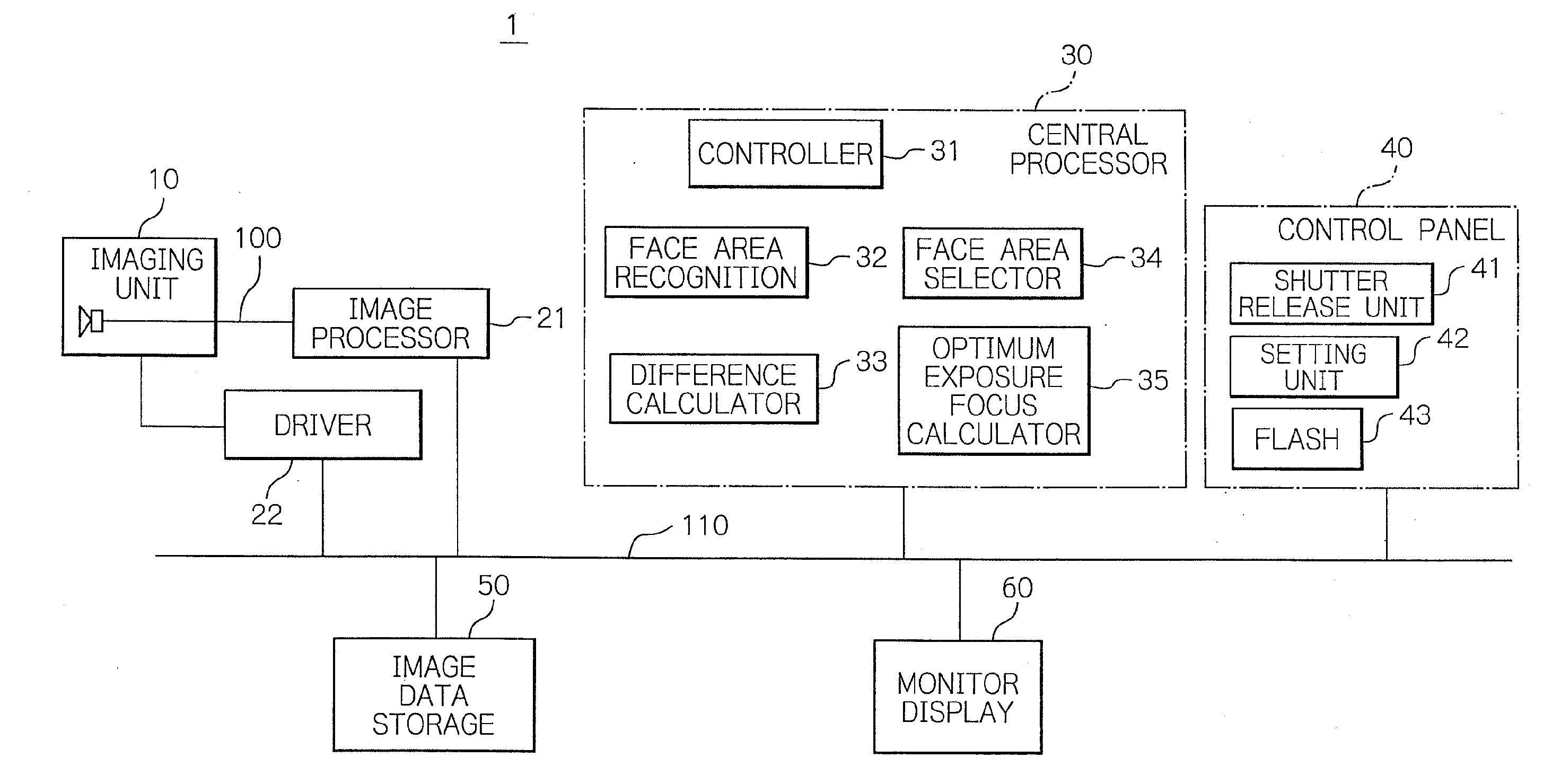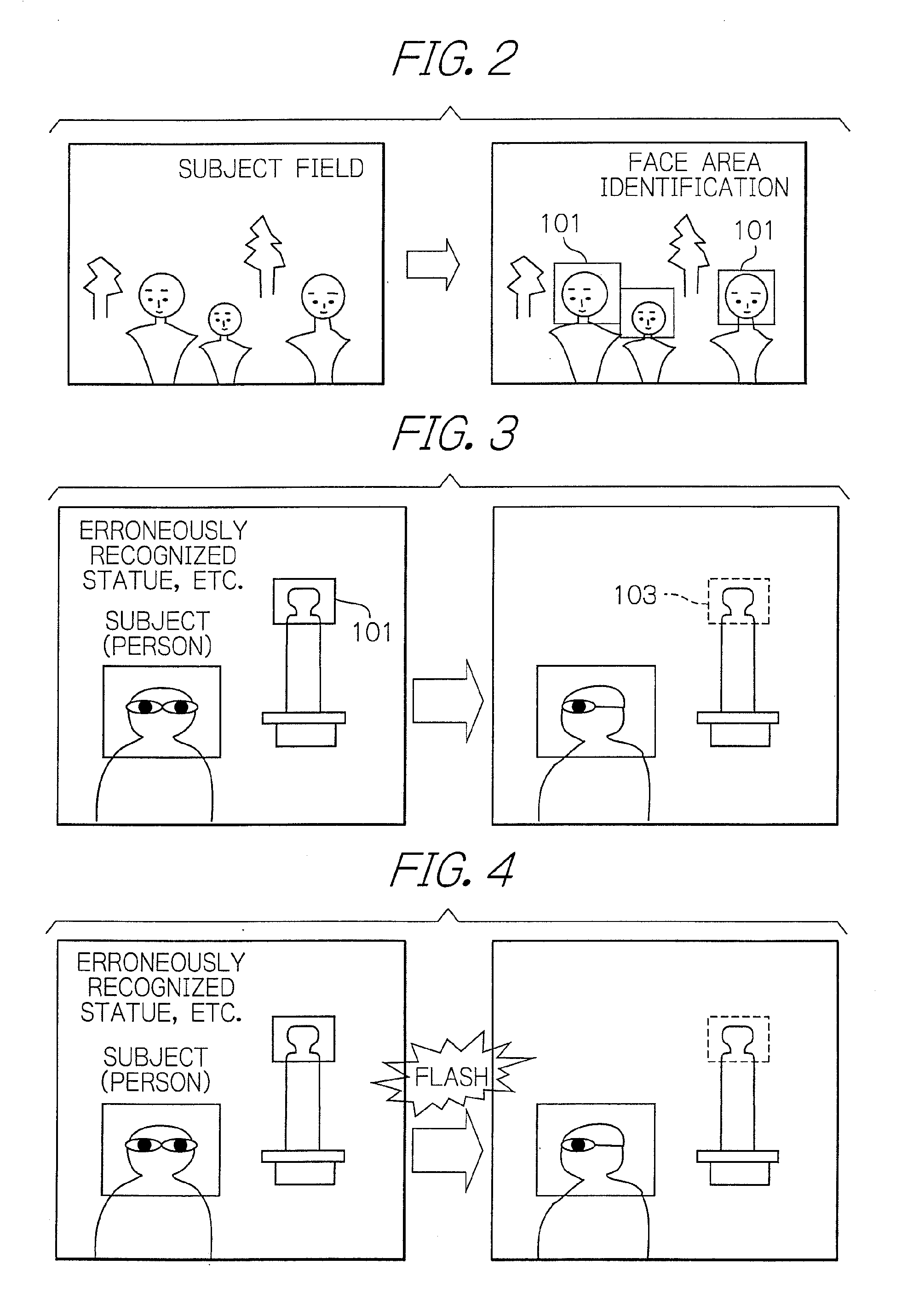Digital camera capable of appropriately discriminating the face of a person
a digital camera and person-sized technology, applied in the field of digital cameras, can solve problems such as the operator's inability to provide the image in a way that is not intended by the operator, and achieve the effect of reducing the number of images
- Summary
- Abstract
- Description
- Claims
- Application Information
AI Technical Summary
Benefits of technology
Problems solved by technology
Method used
Image
Examples
first embodiment
[0036]The digital camera 1 of the first embodiment generally includes an imaging unit 10, an image processor 21, a driver 22, a central processor 30, a control panel or consol 40, an image data storage 50 and a monitor display 60, which are interconnected as shown. The imaging unit 10 and the image processor 21 are interconnected by a connection line 100. The respective sections including the image processor 21 and the image data storage 50 are interconnected over an internal bus 110.
[0037]The imaging unit 10 has optical functions, such as an imaging lens, a mechanical shutter and a diaphragm, and is provided with a photographing system, inclusive of a solid-state image sensor, such as a charge-coupled device (CCD) or metal-oxide semiconductor (MOS) type of sensor. The imaging unit 10 is driven by the driver 22 responsive to commands provided from the central processor 30 to photograph a subject as a preparatory image or as a live image. The so obtained image is sent to the image pr...
second embodiment
[0069]The operation of the digital camera 1 of the second embodiment will now be described with reference to the block diagram of FIG. 9 showing its constitution, the sketches of FIGS. 10 and 11, and the operational flowcharts of FIGS. 12, 13 and 14.
[0070]With the exception of the flash-related operation, the operation of the second embodiment differs from the operation of the first embodiment as to the method for selecting the face area. In more detail, in the first embodiment, the face area recognition subsection 32 recognizes a person of the preparatory image and identifies it as a face area (step s5). The monitor display 60 displays the identified face area with emphasis (step s6). Likewise, in the second embodiment, the face area recognition subsection 32 recognizes a person in the preparatory image and identifies it as a face area (step s52). The monitor display 60 affords face area discriminating data only to the face areas in the preparatory image on the display screen and d...
third embodiment
[0074]With the third embodiment, the operator points to the face area, displayed with emphasis on the display screen, by a cursor operation. By so doing, the cursor unit 80 outputs cursor data, inclusive of the face area discriminating data, specifying the face area indicated by the cursor, in cooperative with the monitor display 60 and the face area recognition subsection 32 (step s73). Further, the face area selector 34 eliminates the face area, relevant to the cursor data, that is, the face area discriminating data, from selection of the set of face areas acting as the photographing reference (step s83). Alternatively, the face area selector 34 selects a face area, specified by the face area discriminating data, as the face area acting as the photographing reference.
[0075]The constitution of the digital camera 1 of the fourth embodiment will now be described with reference to FIG. 19. As contrasted to the constitution of the first embodiment of FIG. 1, the constitution of the fou...
PUM
 Login to View More
Login to View More Abstract
Description
Claims
Application Information
 Login to View More
Login to View More - R&D
- Intellectual Property
- Life Sciences
- Materials
- Tech Scout
- Unparalleled Data Quality
- Higher Quality Content
- 60% Fewer Hallucinations
Browse by: Latest US Patents, China's latest patents, Technical Efficacy Thesaurus, Application Domain, Technology Topic, Popular Technical Reports.
© 2025 PatSnap. All rights reserved.Legal|Privacy policy|Modern Slavery Act Transparency Statement|Sitemap|About US| Contact US: help@patsnap.com



